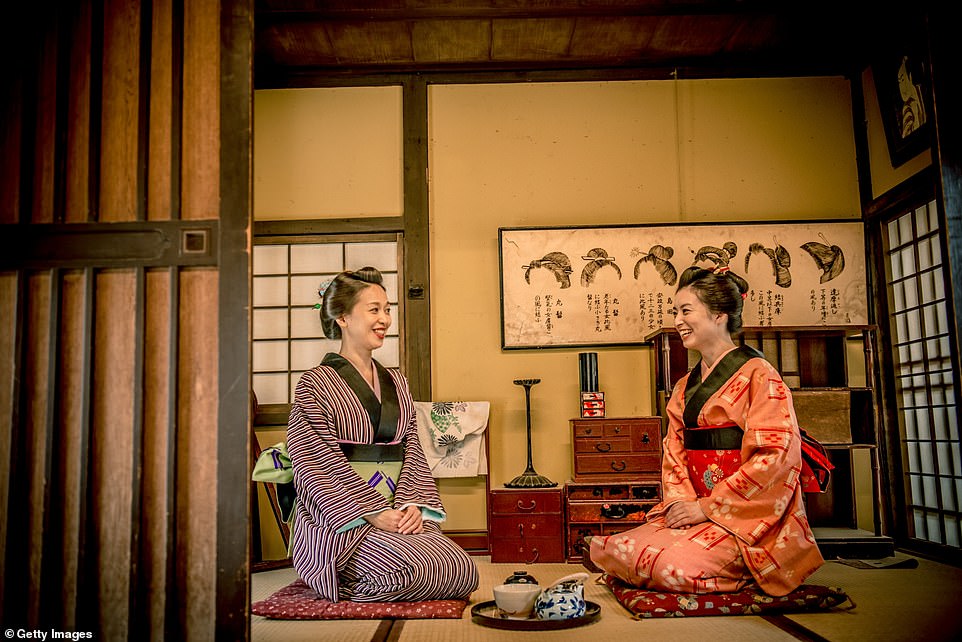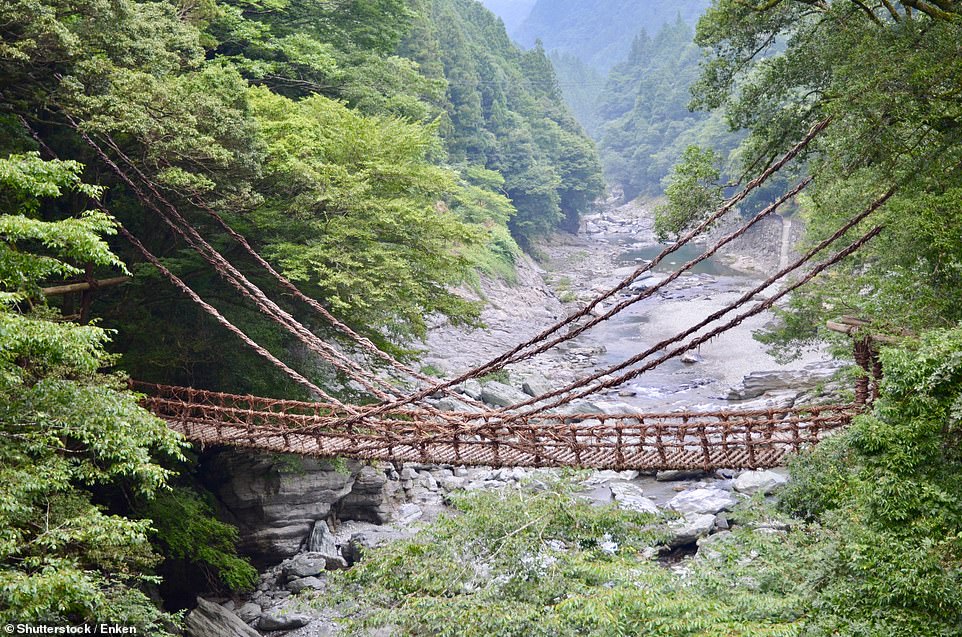All those shiny new pools, sparkling stadiums and miles of delightful countryside — with Mount Fuji popping up every now and again — have served as a reminder of what a fascinating country Japan is.
And for me, these Olympics have brought back vivid memories of a trip I took to the island of Shikoku shortly before the pandemic hit.
It is the second smallest and least visited of Japan’s islands and, because of its historic isolation, has retained many of the country’s traditional characteristics. What I hoped to gain from my road trip was a glimpse of tea ceremonies, misty mountains and thatched-roofed houses. I was not disappointed.

Rise and shine: The beautiful Ritsurin Garden in Takamatsu was laid out by a feudal lord in the 17th century
First stop was Takamatsu, in the north of the island — a bustling concrete metropolis. Here, the street signs are the only indication of where I am. But when I left its honking traffic for the Ritsurin Garden, I stepped into a watercolour. The ‘strolling gardens’ — as they are called — were laid out by a feudal lord in the 17th century, and the ancient black pines, humpback bridges and bonsai-strewn lawns remain pretty much as he left them.
Perhaps inevitably, the highlight was the tea ceremony, launched here in the 1640s. In the ancient teahouse, I kneeled to watch our ‘hostess’ whip the matcha (powdered tea) to a pea-green froth, then, like honoured guests over the centuries, I wandered out with my brew to gaze at the hypnotic clusters of carp in the lake.
In Takamatsu, I stayed in a modern hotel, but my next night was spent at a ryokan, a traditional inn with tatami matting and communal baths. On arrival, I was shown to an empty room, which later acquired a futon, and was handed a yukata — a lightweight kimono-like dressing gown. It proved remarkably forgiving of the multi-course feast served up before I was directed to the women’s bath, where the old hands were moisturising and flossing naked in front of a wall of mirrors.

The matcha tea ceremony has been an integral part of the traditional Japanese culture for centuries

Shikoku is the second smallest and least visited of Japan’s islands
I skipped this step, but happily slipped into the large, warm pool for a long soak, which proved to be considerably more soothing than my usual speedy shower.
The next day, I moved on to explore the Iya Valley, one of the country’s ‘three hidden regions’. Inaccessible and remote with steep mountains still blanketed with forest, the area became a citadel for political refugees from the 12th century onwards, and remained virtually an independent country until the first public road was built in the 1920s.
Here, I mustered my inner Tom Daley and wobbled nervously across one of the few remaining vine bridges poised above a steep river gorge.
Afterwards I felt grateful to return to the safety of my car, from where I enjoyed the misty landscapes on the journey to Ochiai. This turned out to be a hamlet of thatched-roofed houses restored by American Japanologist Alex Kerr.
The softly spoken academic first arrived in Iya in the 1970s, when the old world was still intact. ‘Cooking was done over an open hearth sunk into the floor and people working in the fields wore the woven straw raincoats you see in Samurai movies,’ he said.
Kerr has made it his long-term mission to renovate old houses to rent out to visitors. ‘The Japanese themselves love to go to old towns; they just don’t want to suffer.’

Ochiai is a hamlet of thatched-roofed houses restored by American Japanologist Alex Kerr
Certainly, my stay was suffering-free. I loved the elegant bare rooms divided by fusuma sliding paper doors and lounging in the former hearth, now repurposed as a sofa, warmed by double glazing and under-floor heating.
Though rural communities remain under threat as the younger generation migrates into towns, they do still operate, and a journey along don’t-look-down mountain roads brought me to a form of Japanese Airbnb at a one-woman small holding.
The farmer — an energetic 70-year-old widow — spoke no English, but welcomed me with a huge smile and the international gesture of ‘Come in, come in’. After a generous home-cooked meal — accompanied by rugby on the telly — she pointed to a pile of futons, indicating I should find my own spot anywhere in one of the multi-functional rooms.

The Daily Mail’s Lisa Freedman recalls wobbling nervously across one of the few remaining vine bridges in Iya Valley
My final stop was in Wakimachi, a town that grew rich in the 18th century producing the famous ‘Japanese blue’ indigo dye used in the Olympic flag.
Today, its grand merchant houses have been carefully restored, and wandering through the airy splendours of the Yoshida Family Home, with its carved wooden panelling and peaceful courtyard garden, I had no problem imagining its kimono-clad ghosts.
Later, as I whizzed down the main street on a Brompton bike, past rooftops decorated with family crests and protective demons, I felt I’d managed to see the best of Japan, old and new.
TRAVEL FACTS
Lisa flew with Finnair (finnair.com) from London Heathrow via Helsinki to Kansai International airport. Ritsurin Gardens: my-kagawa.jp/en/ritsurin. Mannaka Ryokan Hotel: mannaka.co.jp. Yokogura Farm Stay: yokogura-inn.com. Wakimachi information: nishi-awa.jp
Advertisement
Source link : https://www.dailymail.co.uk/travel/escape/article-9846771/Japan-backdrop-Olympic-games-looks-impressive-TV-seeing-real-golden.html












